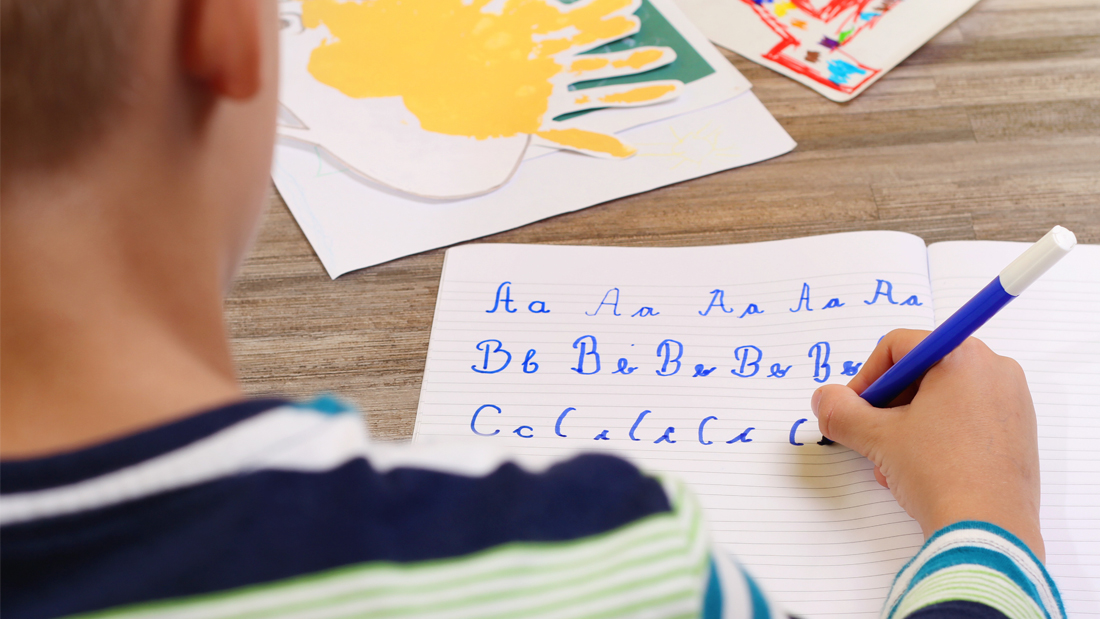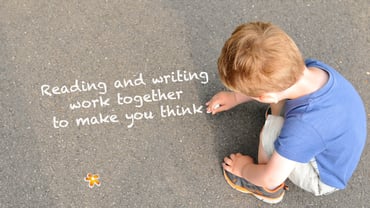Is Handwriting Really THAT Hard?
As an occupational therapist who has worked with children in a variety of school settings for most of my 18 year career, I can tell you definitively that YES! handwriting is THAT hard!
I've seen a significant increase in the expectation of handwriting skills from younger students over the years. Perhaps to meet Core Content Standards, or maybe due to the school's drive to be the top performer in the district, children are expected to write sooner, better, and faster than ever before. Interestingly enough, many schools have removed handwriting from the curriculum and most have eliminated the use of cursive completely. I’m not here to stand on my soapbox about schools and handwriting, but I am here to tell you about the skills a child must have before handwriting can come to them with ease.
Let’s think of it as building a castle. You can’t put the tower on the castle without laying the foundation, supporting the walls, and getting just the right angle for the roof, right? Well handwriting is just like the tower. The rest of the pieces have to be established, solid, and permanent.
Foundational Skills
The foundational skills for handwriting start at the brainstem level—receiving and integrating sensory input from the body and the environment.
Without strong vestibular (knowing where your head is in space) processing, it’s near impossible for you sit upright in a chair and have head movement (watching the teacher, looking up at the board, looking down at the paper, looking under the desk for a dropped pencil) without falling off the chair.
Without integrated visual input, it’s extremely hard to track the teacher as she walks around the room, scan a worksheet/book without loosing place, or find the exact spot on the tiny unlined paper where you are to write your response.
Without a finely tuned tactile (touch) system, your hand won’t be able feel the pencil correctly. This may cause you to either hold the pencil too tightly and your hand will cramp, or you’ll hold it too loosely and drop it often.
Without a glitch-free proprioceptive (feeling and using force) system, you may press too hard and repeatedly break your crayon or snap the tip of your pencil, or you may rip the paper when erasing.
Without an optimally functioning auditory (making sense of sound) system, you’ll miss verbal directions (oh how hard those spelling tests will be!) or will be behind in turning to the right page in your workbook.
So let’s say your sensory system is pretty solid. You’re not falling out of a chair, you don’t break your pencil, you can read without losing place, and you don’t miss teacher directions. Awesome. You’ve got a foundation. Can your tower remain atop your castle now, just because you have a foundation? Nope.
Support Walls
Let’s talk support walls.
Gross motor skills are larger movements. Those are needed to reach for and acquire necessary materials. Carrying those heavy textbooks from your cubby/locker to your desk, or hauling around a 20lb backpack is dependent on the skills of your gross motor muscles.
Fine motor integration is when the tiny muscles of your hands can work repeatedly and consistently with controlled force and precision. Pencils are skinny. You have to hold them just right in order for the lead to contact the paper at just the right spot. Your fingers bend and stretch differently for each letter. It’s also a super coordinated motor task to flip your pencil around from the lead tip to the eraser.
Bilateral integration is when both sides of the body work together to complete a task. If you’re a righty, your left hand will be responsible for stabilizing the paper as you write so that it doesn’t slide off the desk. You also need to use both hands to uncap a marker or use a ruler.
Visual motor integration is when your eyes and hands (or feet) work seamlessly together to complete a task. Oftentimes, there is no obvious visual impairment, but one eye is weaker than the other so fixation (keeping your eyes on a person or object for a sustained amount of time) is super hard, as is convergence (looking closely) and divergence (looking further away). These weakness can get missed during routine vision checks. If your eyes aren’t teaming well, you may tilt your head, hold your face close to the paper, cover or close one eye, or complain about headaches. (Call for an evaluation by a developmental optometrist if this is the case!)
So your support walls are pretty solid, you say? That’s fabulous! You’ve got a foundation, you’ve got supporting walls. Can your tower be added? You may be able to balance it up there for a few minutes, but inevitably it’ll come crashing down without your precisely angled roof.
Precisely Angled Roof
The precision of that angled roof is key. This is where the higher level cognitive skills come in. Most people can follow DIY directions to lay a foundation or get support walls up. But a trained architect is needed for those beautifully designed roof angles. The architects we need are what’s found in our cortex. This is the super center of the brain. This is where we develop praxis (the thought of, planning for, sequencing of, and the execution of our plan). Praxis is what you utilize to know exactly where on the paper to start your letter, how big it should be, how it’s formed, and how close it needs to be to other letters. In addition, you must be able to generate a thought about what it is you’re planning to write. Imitating letters is easiest. You have someone showing you exactly what you need to do and where. Copying letters is a little harder—you know what and where the letter needs to be, but making the letter is now your responsibility. Writing without a sample requires you to be responsible for all of the parts. Now, think about how challenging it is to first think of something you want to write about (especially if it is as abstract as a daily journal entry in your first grade notebook) and then have the working memory to remember that though as well as have the praxis to execute that thought.
Are you tired yet? I am! So, we have foundation, we have walls, and we have the beautiful roof. The tower (our completed, legible writing) can sit on top and we can marvel in it’s splendor. Whew! You’re done!
Wait? You mean you’ve just constructed this amazing castle with a perfectly placed tower and now the teacher or your parent say you have to do it again? And again? And again?
Rest assured, that with repetition and practice, you will refine your skills and become an efficient and excellent writer. But none of this will happen unless you acknowledge, address, and establish all the skills I’ve just mentioned.
If your child is struggling with handwriting, schedule an OT evaluation. Occupational therapists are trained in evaluating and building the foundational skills needed for excellent written output.
Is Handwriting Really THAT Hard?
Nicole Newell, MS, OTR/L
Nicole Newell, MS OTR/L is the Clinical Director for Carolina Pediatric Therapy, a large, dynamic company that provides therapy to children across 18 counties of Western North Carolina. She graduated from Misericordia University in 1998 with a bachelor’s in psychology and a masters of occupational therapy. She has spent her 18 years as an occupational therapist specializing in sensory integration and treatment of children with autism.
Want to know how a Therapist can Help?
Call (828) 398 0043 or click on the schedule button.



